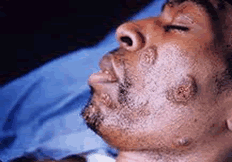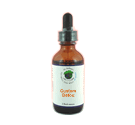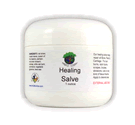|
|
Coccidiodes
 |
Coccidioides fungus causes Valley fever (also called coccidioidomycosis), an infection that occurs when spores of the fungus enter your body through the lungs. Valley fever is most commonly seen in the desert regions of the southwestern United States, and in Central and South America. The infection is transmitted by breathing in fungal particles from soil and is not spread from person to person or from animals to people. The fungus changes its form when it infects a person, but this form cannot be transmitted from one person to another.
Most of the people who get the disease live in or visit places where the fungus is present in the soil. Exposure also occurs through engaging in activities that stir up dust such as construction, agricultural work, military field training and archeological exploration. Natural disasters such as dust storms and earthquakes can also expose people to the Coccidioides fungus. Those with a weakened immune system are more likely to develop a serious infection. People of Native American, African, or Philippine descent may also have more severe cases.
Most people with coccidioidomycosis never have symptoms. Others may feel as though they have a cold or flu. If symptoms occur, they typically start 5 to 21 days after exposure to the fungus. Common symptoms include: ankle, feet, and leg swelling, chest pain (can vary from mild to severe), cough (possibly producing blood-tinged phlegm (sputum), fever and night sweats, headache, joint stiffness and pain or muscle aches, loss of appetite, and painful, red lumps on lower legs (erythema nodosum).
The infection, in rare cases, spreads from the lungs through the bloodstream to involve the skin, bones, joints, lymph nodes, and central nervous system or other organs. This is called disseminated coccidioidomycosis and may include the following symptoms: change in mental status, enlarged or draining lymph nodes, joint swelling, severe lung symptoms, neck stiffness, sensitivity to light and weight loss.
|
|
| |
Coccidiodes Detox Remedy
Detoxification of all Coccidiodes species
$14.95
Read/Write Reviews
|
 Add
To Cart Add
To Cart |
 |
 |
Healing Salve
Heal and regenerate any skin issue.
$16.95
|
 Add
To Cart Add
To Cart |
 |
 |
Mycotoxins Detox Remedy
Detoxification of all Mycotoxins species
$14.95
|
 Add
To Cart Add
To Cart |
 |
 |
MMS Combo (4oz ea)
The best germicide known to man
$34.95
|
 Add
To Cart Add
To Cart |
 |
 |
|
|
 Arthropod/Vector
Bacteria
Chemicals
Fungus /Mold
/ Yeast Metals Parasites Virus Other
Arthropod/Vector
Bacteria
Chemicals
Fungus /Mold
/ Yeast Metals Parasites Virus Other




